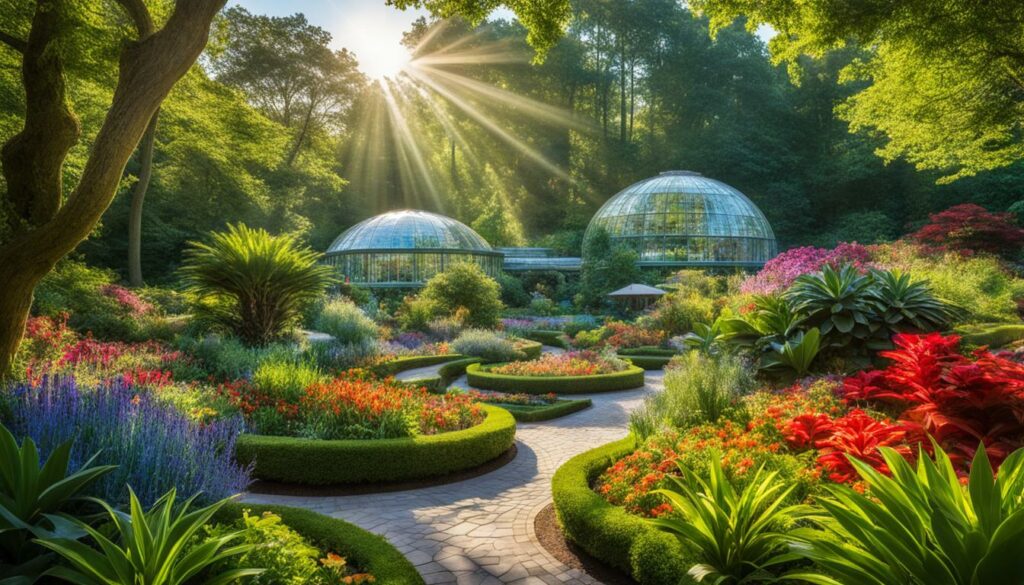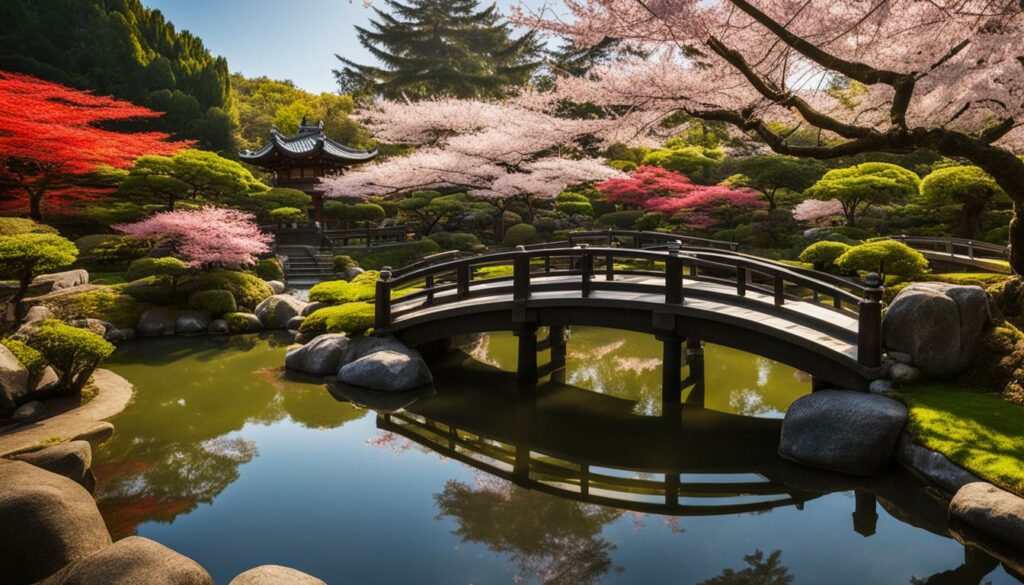“If you have a garden and a library, you have everything you need.” — Marcus Tullius Cicero. With these timeless words echoing through the ages, we unearth the profound connection between the cultivation of the earth and the cultivation of the mind. As we delve into the historical gardens that have shaped our conception of beauty and utility, we are possessed by the spirits of bygone eras, enveloped in a world of garden history and monumental famous gardens of the world.
From the manicured grandeur of French châteaux to the tranquil symmetry of Japanese Zen gardens, each historic landscape is a chapter in the earth’s memoirs, penned by the hands of visionary gardeners. The heritage gardens that have stood the test of time offer a vast repository of lore for the contemporary garden preservation enthusiast. As we explore the intricacies of garden design, we find that the excellence of botanical gardens and the allure of notable gardens are more than aesthetic—they are timeless principles we can sow in our modern lives.
The great historical gardens offer up their lessons generously, allowing us to witness the dance of culture and nature. They guide us in shaping our own green spaces, ensuring that the legacy of garden history continues to blossom under our care.
Key Takeaways
- Historical gardens are a rich resource for understanding past garden design techniques and styles.
- Preserving famous gardens allows us to maintain a physical connection to gardening history and heritage.
- Lessons from historical gardens inspire modern landscapes and botanical designs.
- Historical landscapes act as living archives, helping us to safeguard garden traditions.
- The principles behind heritage and notable gardens can be adapted to current gardening practices for sustainability and beauty.
- Garden preservation involves both maintaining historical sites and incorporating their wisdom into contemporary garden aesthetics.
Unlocking the Secrets of Heritage Garden Mastery
The artistry of historical gardens is not confined to the pages of history; instead, it continues to influence modern garden design. Immortalized in the structured beauty of heritage gardens and manifesting in notable gardens across today’s landscapes, the legacy of past masters blooms afresh. Through careful garden preservation, we not only pay homage to these timeless spaces but also apply their principles to the green canvases of our time.
The Influence of Gardening Greats on Modern Practices
In today’s quest for sustainability and beauty, the wisdom of gardening pioneers like André Le Nôtre and Thomas Jefferson is more relevant than ever. Their approach to creating functional yet magnificent historic landscapes guides us in crafting spaces that withstand the test of time. It’s this storied past that guides our hands in nurturing botanical gardens and private sanctuaries alike.
Design Principles from André Le Nôtre to Piet Oudolf
André Le Nôtre, the architect behind some of France’s most extravagant gardens, created symmetrical patterns and an illusion of infinity that continue to resonate in the garden designs of the 21st century. Piet Oudolf, with his perennial garden designs, like New York City’s High Line, offers a modern take that similarly interweaves visual appeal and ecological function. This seamless blend of old and new reflects the dynamic nature of garden artistry.
Cultivating Early Crops: Advice from Thomas Jefferson’s Gardens
Thomas Jefferson’s horticultural legacy nurtured the idea of microclimates long before they were common knowledge. His nurturing of early crops serves as a blueprint for contemporary gardeners looking to extend their growing seasons and maximize yield. His love for peas evolved into strategies that are still implemented in notable gardens today, providing a successful harvest through heritage techniques.
As we honor these masters, their insights come to life in the restoration of historical sites and the inventive application of classic aesthetics in new, green spaces. Below, you’ll find a comparative display of how these historical figures have impacted modern garden elements:
| Historical Influence | Modern Element |
|---|---|
| André Le Nôtre’s Symmetry | Contemporary Geometric Layouts |
| Thomas Jefferson’s Microclimates | Climate-Sensitive Planting Techniques |
| Piet Oudolf’s Perennial Gardens | Sustainable Public Landscapes |
Through dedication to garden preservation, these legacy gardens continue to teach us, enriching our understanding and execution of gardening in the modern era. Let us walk in the footsteps of these horticultural visionaries, creating vibrant, living tributes that weave the essence of historical mastery into the very fabric of today’s gardens.
Gardens as Gateways to Cultural and Historical Understanding
Reflecting on garden history, we see that gardens are deeply intertwined with our cultural and historical fabric. Serving as more than spaces of beauty and tranquility, gardens are dynamic storybooks that tell tales of the past, manifesting the spirit of the times in which they were conceived. Key events such as Tulipmania not only influenced economic trends but also altered the horticultural landscape, making a significant impact on gardens history.

Historical moments echo in the structured hedges of botanical gardens and the untamed allure of wildflower meadows, each ground-covering the evidence of societies’ ever-evolving relationship with nature. From the pragmatic use of plants during the Lewis and Clark Expedition to the diverse flora in Thomas Jefferson’s Monticello, gardens represent the intersection where human endeavors meet the natural world.
- The Three Sisters Garden – an homage to Native American agricultural techniques and sustainable practices.
- The Chinampas – innovative Aztec floating gardens displaying ancient engineering and food production.
- Bonsai cultivation – a Japanese art form symbolizing patience, thoughtfulness, and a connection to the miniature landscape.
These notable gardens do more than just showcase plants; they act as a portal to the insights and practices of those who tended them. George Washington Carver’s contributions extend beyond peanut agriculture to innovative botanical research that has influenced generations. Furthermore, school gardens today serve as practical settings to inspire and educate young minds about the importance of garden history and sustainability.
| Garden Type | Cultural Significance | Historical Contributions |
|---|---|---|
| Botanical Gardens | Educational centers for plant diversity and conservation | Advancement of botanical sciences |
| Historical Gardens | Reflections of aesthetic and philosophical beliefs of their times | Promotion of landscape architecture as an art form |
| Personal Gardens | Insight into significant historical figures’ lives and legacies | Personal research that shaped agricultural and botanical knowledge |
It is imperative to preserve these living chronicles, as they grant us intimate insights into the cultural and historical narratives of bygone eras. In doing so, we connect more deeply with both our heritage and our ecology, ensuring that the stories told by gardens continue to flourish for future generations to learn and appreciate.
Historical Gardens, Garden History, Famous Gardens of the World
As we delve into the history of gardening, we uncover a tapestry of heritage gardens that tell the story of civilizations, cultural exchanges, and a deep-rooted connection with nature. Historical gardens are not merely spaces of beauty; they are pivotal chapters in the book of garden history, providing insight into the lives and times of past societies. These gardens—from the precise lines of French formal gardens to the tranquil pathways of Japanese zen gardens—have shaped the present heritage gardens we strive to preserve.

The influence of famous personalities like Rosemary Verey, who championed the English romantic style at the Barnsley House, is keenly felt across global landscaping. These iconic spaces—whether royal or rustic—have left unparalleled legacies in the world of horticulture. The iconic Versailles gardens set a new standard for grandeur, while the victory gardens of wartime America showcased resilience and resourcefulness, emphasizing the historical strength we find in tending the earth.
Within the United States and beyond, famous gardens of the world have been carefully cultivated over centuries. Their preservation allows us to walk in the footsteps of the past, to learn from the ingenuity of traditional practices, and draw inspiration for future botanical gardens and landscapes. These spaces highlight the enduring aesthetic, ecological, and educational value of historical gardens. Let’s explore some of the most captivating historic landscapes that have influenced modern garden design:
| Historical Garden | Location | Influence on Garden Design | Notable Features |
|---|---|---|---|
| Versailles | Versailles, France | Formal French garden style, symmetry, and grand scale | Expansive lawns, intricate parterres, and elaborate fountains |
| Kenrokuen | Kanazawa, Japan | Serenity, natural beauty, balance | Kasumi Pond, Kotoji-toro lantern, and the oldest fountain in Japan |
| Kew Gardens | London, England | Conservation of plant species, botanical research | World’s largest collection of living plants, Victorian glasshouses |
| Central Park | New York City, USA | Urban public park movement, natural landscape design | The Ramble, Bethesda Terrace, and Bow Bridge |
As we continue to walk along the paths of these famous gardens of the world, we not only celebrate their beauty but also their contributions to garden history. It’s our shared responsibility to protect these historic landscapes and to keep the dialogue between past and present alive in the green spaces we cherish today.
Conclusion
As we delve into the rich tapestry of garden history, we unearth a treasure trove of horticultural brilliance that continues to shape modern practices. The time-honored principles of garden design and the tireless efforts of historical figures like André Le Nôtre and Rosemary Verey serve as a foundation upon which today’s garden preservation efforts are built. Their mastery in cultivating historic landscapes and botanical gardens leaves a lasting heritage that enriches our understanding and application of sustainable and aesthetically pleasing garden spaces.
Embedding the Past into Today’s Horticultural Practices
The synergy between past and present garden practices is palpable in the verdant layouts of contemporary heritage gardens. By meticulously fusing classical elements with modern techniques, a new generation of green spaces emerges, bearing the hallmark of historical ingenuity while embracing innovative approaches to horticulture. This sustainable evolution in garden design bridges the ages, ensuring that lessons from heritage gardens continue to inform and inspire.
Celebrating the Intergenerational Wisdom of Cultivation
The chronicles of great cultivators like Thomas Jefferson and George Washington Carver are not merely memories of the past but are alive in the diligent efforts of today’s gardeners. Their shared wisdom serves as a guiding light, leading us to honor the history of gardens by adopting heirloom crops and venerating enduring garden principles. It is in the nurturing of these green spaces where the legacy of past garden luminaries is safeguarded for future generations. Gardeners today are tasked with the noble undertaking of not just maintaining but also enriching the narrative of our connection to the earth—and through this, the beauty and rich history of the world’s famed botanical and heritage gardens continue to flourish.








